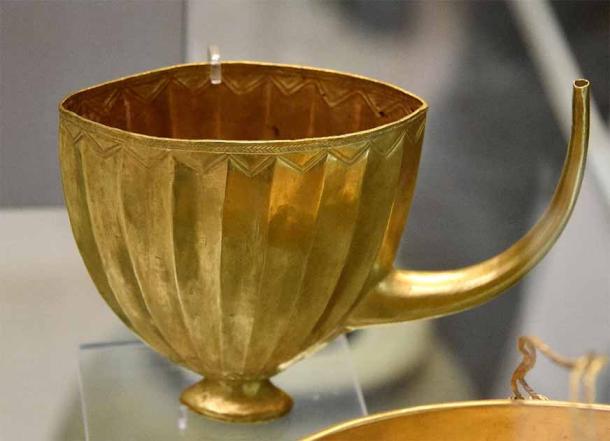The Human Fascination With Gold Throughout History
Gold and humans have a very special relationship, and humans still think that gold is one of the most valuable materials on the planet. In this article, you can find an overview of the history of gold, its discovery, value, and symbolism throughout the centuries.
Gold has a fascinating history, and it is extremely valuable for us. Kings, wizards, and emperors always knew that it was a special material, and by reading this article, you will understand why.
When Was Gold Discovered?
The exact time, location, and circumstances behind the discovery of gold and its properties are mysterious. It was likely found in rivers or lying on the ground, ‘native’, in some form of natural nugget or even small specs.
Although the origins of gold use by humans must lie further in that past, the earliest artifacts found that are made of gold date back to the 5th millennium BC, from the Varna necropolis in Bulgaria.
- The Shining History of Gold: From Ancient Treasure to Modern Tech
- Hi-tech Metal Furnace of the Negev Alchemists Incinerates History

The elite male burial found at the Copper Age Varna necropolis (4600-4200 BC). (Yelkrokoyade/CC BY SA 3.0)
Gold jewelry and a decorated gold handled knife has been found buried in the Tomb of Djer, third king of the First Egyptian Dynasty, at Abydos, Egypt from circa 3000 BC. There is also evidence of an Egyptian alchemist named Zosimos, who allegedly was the first person to find pure gold.
Gold items have been recovered from the Royal Cemetery of Ur, in Southern Mesopotamia, showing a reverence of gold and skills of gold working from Sumer around 2600 BC.
Gold is known to have been mined in Nubia by around 2450 BC, and it was found to be full of the appealing metal, which would soon become the standard medium of exchange internationally. Egypt became an incredibly wealthy nation due to control of these reserves. A Shekel coin weighing 11.3 grams of a gold/silver alloy was introduced as the standard currency in the Middle East.
The undying value of gold was being established for the world.
- Maya Wealth Inequality Was Linked to Despotism, Claims Belize Study
- Neolithic Wealth Gap Wasn’t Just for the Living

Gold vessel with a long spout that would probably have been used as a drinking straw, from the Royal Cemetery at Ur, Southern Mesopotamia, modern-day Iraq, Early Dynastic Period, c. 2600 BC. (©The British Museum, London.)
Gold is scarce, and because of this, it gains value with each passing year. In the next section, you will read more about the characteristics that gold has that make it so valuable, but for now it is interesting to trace a comparison between the price of gold and the Bitcoin price near 80K. Both gold and Bitcoins are considered extremely valuable due to their scarcity.
What Makes Gold Valuable?
Nowadays, almost everything can be created in a lab, but gold can’t. From way back to 300 BC, alchemists of ancient Alexandria were trying to produce gold from base metals, and others tried right up to the Renaissance with no success.
Gold has several characteristics that might give it the value we know of today. First of all, it looks beautiful, with its color and brightness. This was likely the initial attraction to the material. But it is also durable, does not tarnish, and even considered to be virtually indestructible and yet malleable, which actually makes it useful in the modern world. It is one of the densest metals and a good conductor of heat and electricity, and so is valuable for engineering and technology today.
But what makes gold such a valuable material is its perceived value, which is a tradition and dogma of past times. Almost every civilization that came into contact with it gave it an ethereal and magical kind of power. From the ancient Egyptians to the Minoan, Assyrian, and Etruscan and most other civilizations, gold continued to be widely used for jewelry and decorative objects alike.

Scythians of the 9th-4th centuries BC are famous for their gold work and horsemanship. Scythian gold plaque depicting a Scythian rider with a spear. (Public domain)
Gold in Modern Times
In more modern times, this material was universally accepted in exchange for goods and services. Interestingly, Russia became the world’s leading producer of gold in 1823, and during the following years, more gold was produced in the world than in all the years since 1492. This is widely dependent on the gold that was found in California and Australia. Many were the places where gold was found, but this material remains rare nonetheless.
Not everyone knows that pure gold is too soft to resist prolonged handling, and because of that, it is often alloyed with other metals, which will make it harder, and, therefore, more adequate to be used in jewelry and other practices. Silver is one of the most common metals gold is alloyed with, together with copper and zinc.
Magical Properties of Gold
As mentioned, gold has often been linked to some magical, spiritual, and mystical properties. As it is chemically inert, this material is also believed to prevent spiritual corrosion, fatigue, and even negativity. From a mystical point of view, gold symbolizes the purity and spiritual aspects of the universe, and it allegedly allows people to be present and maintain communication with the ultimate source of all beings.
Often, gold was used in religious ceremonies, and it features heavily in the Catholic church. From a folklore point of view, gold was believed to bring good luck, and very much like copper, it was thought to keep evil spirits away.
Ever Popular?
However, there have been instances in history when gold went out of fashion. According to more than 4,500 artifacts found by researchers, an early society located between the Black and the Caspian Seas lost its appreciation of gold. According to an analysis of the artifacts, this lack of popularity for gold remained the same for about 700 years. Researchers have shown that gold items became rare across a large part of the territory for a period of time between 1500 and 800 BC.
This is an interesting piece of history because it reminds us that value is not an unwavering and universal matter, but it can change with circumstance. In other words, the way humans value gold is not a constant in space and time. The current global human civilization continues to hold gold in extremely high regard but there are certainly other materials now with equal and higher value and utility in the current technological world. So, what will the value of gold be in the future?
Top image: Pile of gold bullion coins and bars. Argor Heraeus, Münze Österreich, Royal Canadian Mint, U.S. Mint, Australian Mint of Perth, panda and Krugerrand. Source: Zlaťáky.cz/Unsplash
By Sadie Smith

















